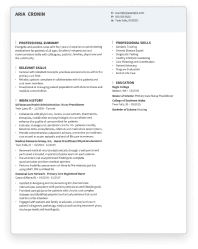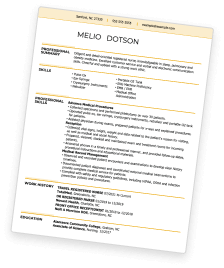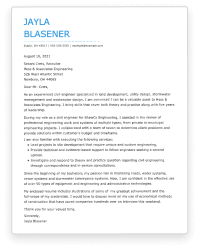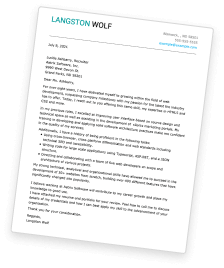Medical Assistant Resumes: Overview
As a medical assistant, you help with administrative and clinical tasks so physicians can focus on their patients. You are responsible for taking medical histories, measuring vital signs, scheduling appointments, collecting samples, and entering patient information.
You play a critical role in keeping things organized and running smoothly in a variety of healthcare settings, including:
- Hospitals
- Clinics
- Private Practices
- Nursing Homes
- Urgent Care Centers
Wherever you end up, at Hloom, we’re here to help you build the best resume possible.
Explore our guides and tips for building a medical assistant resume, showcasing your mastery of essential skills such as medical terminology, patient care, and working well with a healthcare team.
Take a look at our professional examples and use a customizable resume template to get your next job as a medical assistant today!
Medical Assistant Resume: Choose a Format
Selecting the right format is the first step to creating a successful medical assistant resume. Choose a format that will highlight your strengths, whether you’re emphasizing work experience, skills, or a combination of both.
There are three resume formats for a medical assistant to consider: chronological, functional or a combination resume. Let’s take a closer look at each format’s benefits and possible drawbacks.
Chronological Resumes for Medical Assistant
A chronological resume will showcase your steady career progression in the medical field.
We highly recommend choosing this. It is the most popular resume format because it is familiar to employers and is highly compatible with applicant tracking systems (ATS).
A chronological format emphasizes your work history, so it is an excellent choice for an experienced medical assistant.
In this format, you would list your previous jobs in reverse chronological order and then provide details about your responsibilities and accomplishments in bulleted sentences beneath each job entry.
Functional Resumes for Medical Assistant
A functional resume format, on the other hand, will emphasize your skills and qualifications instead of your work history. It can be ideal for those transitioning careers, just starting their career as a medical assistant, or with gaps in employment.
In a functional resume for a medical assistant position, you include detailed information about your skills and qualifications to highlight your ability to do the job.
While this can work well for a recent graduate, it is important to note that this format is incompatible with ATS, and many employers prefer a detailed work history. Be sure to consider these potential drawbacks when choosing your resume format.
Combination Resumes for Medical Assistant
The third option to consider is a combination resume format. You can blend elements of chronological and functional formats with a combination resume to get the best of both worlds.
This format places your skills and qualifications at the top of the resume to bring attention to your unique qualifications, then provides a detailed chronological work history. A combination resume places equal emphasis on your skills and your work experience.
This format is perfect for medical assistants with limited relevant work experience or a gap in their career.
Choosing a Resume Format
When crafting your Medical Assistant resume, choose a format that aligns with your strengths. If you are unsure which format will work best for you, experts say that a chronological resume is always a safe choice.
Chronological resumes are ATS-friendly and suitable for all experience levels. If you have limited relevant experience, you can tailor your resume to showcase how your skills and expertise transfer well to a medical assistant role.
For example, if your previous roles included customer service, administrative tasks or maintaining databases or files, that experience will transfer well to your next job as a medical assistant.
You can also use keywords from the job description to show your alignment with the role and to help your resume get noticed!
How to Write a Medical Assistant Resume
Once you have chosen your resume format, the next step is to write your resume content. Knowing how to write an effective resume is crucial to getting your medical assistant job, so make sure to get everything right!
Every professional resume includes five essential sections:
- Contact Information
- Summary or Objective Statement
- Work History
- Skills
- Education
Each section of your resume is integral to creating a professional resume for a medical assistant. Keep exploring this guide to learn how to make each section grab the reader’s attention to get noticed by hiring managers!
Contact Information
Start your resume by providing your contact information, placing it at the top of the document so it is easy for employers to find. Ensure your contact information is both accurate and professional.
Your contact information should include:
- First and Last Name
- City and State
- Email Address
- Telephone number
You can also include your LinkedIn profile if you like. A LinkedIn profile can provide additional information to employers, but be sure your picture and profile information are current.
The contact information on your medical assistant resume may look something like this:
Jane Doe
Houston, TX
janedoe@fake.email.com
(555) 123-4567
fake.linkedin.com/in/janedoe
Summary or Objective
Next, you will craft a compelling summary or objective statement to capture the reader’s attention and make them want to continue reading.
A resume summary is well-suited to an experienced medical assistant because it provides a brief overview of your experience level and most relevant skills. This is a great chance to highlight your most relevant qualifications as a medical assistant, which will help you stand out as a job applicant.
Here’s a well-written example of a resume summary for a medical assistant resume:
“Detail-oriented medical assistant with 5+ years of experience providing exceptional patient care and administrative support in fast-paced healthcare settings. Trusted with sensitive patient information and able to adapt quickly in a fast-paced medical setting.”
However, an objective statement may be a better choice if you are new to being a medical assistant.
A resume objective is a brief introduction expressing your genuine interest and enthusiasm for the work and providing insight into your skills and qualifications for the job. This gives entry-level medical assistants and those changing careers an opportunity to underscore their passion to do good work.
For example, an objective statement for a medical assistant job may look like this:
“Energetic and hard-working medical assistant seeking to apply my educational background, organizational skills, and attention to detail to ensure the smooth operation of a busy medical practice.”
Whether you choose a resume summary or an objective statement, remember to tailor it to the job you are applying for. Use keywords from the job description to show your alignment with the role, and let hiring managers know you did your homework.
Pro Tip: Writing a resume summary or objective statement is another way to make your medical assistant resume ATS-friendly.
Work History
Next, you will detail your work history. Start by listing your previous jobs in reverse chronological order, starting with your most recent position and working backward.
Each job entry should include your job title, employer’s name and location, and the dates you were employed.
Then, write at least three bulleted sentences beneath each job entry with clear, concise descriptions of your responsibilities and achievements.
To stand out as a medical assistant candidate, showcase your most relevant experience and accomplishments, basing these on the job description for the position.
For the work history section of your medical assistant resume, make use of strong action verbs like assisted, organized, administered, or scheduled to create a compelling resume.
Also, quantify your achievements with numbers and percentages to validate your impact in each role. Employers love seeing measurable experience and achievements because it gives them more specific context to your value as an employee.
Here’s an example of a well-crafted job entry in a medical assistant resume:
Medical Assistant | XYZ Medical Center | June 2018 – Present
- Conducted patient assessments and assisted in medical procedures.
- Managed patient appointments and scheduling for a busy physician’s office with over 1,000 active patients.
- Maintained exam rooms to follow all health and safety protocols, including sanitizing equipment and ensuring compliance with COVID-19 safety guidelines.
Remember, always tailor the information under each job entry to each medical assistant job application. This shows that you are serious about the position.
For instance, suppose the job posting mentioned that the medical assistant is required to explain treatment procedures to patients.
In that case, you might provide details about how you have instructed patients about procedures, medications, and other treatments in your previous jobs, as well as quantifiable results from your actions.
A hospital administrator or hiring manager will be able to read from this that you are clearly qualified for the role’s responsibilities.
Skills
To write an effective medical assistant resume, you will also need to create a dedicated skills section. In this section, you will list both hard and soft skills to present a well-rounded profile.
Tailor this section to the job description to help your resume pass initial screenings by ATS and to show your alignment with the role, especially with technical skills that are greatly sought after.
To help you get started, here are the top five hard skills and soft skills for a medical assistant resume:
Top 5 Hard Skills for Medical Assistant Resumes
- Medical Terminology: Mastering medical terminology is crucial for effective communication within healthcare settings. Including this skill on your resume showcases your ability to understand and use specialized language, ensuring seamless interactions with healthcare professionals, patients, and other staff members.
- Patient Care: Patient care is the cornerstone of a Medical Assistant’s role. Demonstrating your proficiency in providing compassionate and efficient care not only enhances the patient experience but also underscores your commitment to delivering high-quality healthcare services. This skill is vital for building trust and ensuring positive patient outcomes.
- Administrative Skills: Efficiently handling clerical tasks is essential for maintaining streamlined operations in a healthcare environment. Including administrative skills on your resume emphasizes your ability to manage appointments, handle medical records, and ensure the smooth flow of daily tasks. This skill set is instrumental in supporting overall clinic efficiency and organization.
- Vital Signs Measurement: Proficiency in monitoring and recording vital signs is critical to accurate patient assessments and timely interventions. This skill demonstrates your ability to assess and respond to changes in a patient’s condition, contributing to the overall safety and well-being of those under your care.
- Electronic Health Records (EHR): In today’s digital age, expertise in managing electronic health records is indispensable. Including EHR on your resume highlights your ability to navigate digital platforms, input and retrieve patient information, and contribute to the efficiency of healthcare practices. This computer skill is essential for maintaining accurate and up-to-date patient records.
Top 5 Soft Skills for Medical Assistant Resumes
- Communication: Clear communication is paramount in healthcare settings. Including this skill on your resume underscores your ability to convey information effectively with patients, colleagues, and other healthcare professionals. Strong communication skills contribute to a positive patient experience and promote collaboration within the healthcare team.
- Empathy: Displaying empathy is essential for fostering a supportive and compassionate healthcare environment. Including this skill on your resume reflects your ability to understand and connect with patients on a deeper level, ensuring their emotional well-being and satisfaction with the care they receive.
- Multitasking: The ability to juggle various responsibilities is vital in the fast-paced and dynamic medical environment. Including multitasking as a skill on your resume highlights your capacity to manage multiple tasks efficiently, ensuring that patient care, administrative duties, and other responsibilities are handled seamlessly. This skill is instrumental in maintaining high productivity in a healthcare setting.
- Team Collaboration: Collaboration is key to providing optimal patient care. Including team collaboration as a skill on your resume showcases your ability to work seamlessly with healthcare teams, fostering a cooperative and harmonious work environment. This skill is essential for achieving comprehensive and coordinated patient care.
- Attention to Detail: Ensuring accuracy in medical records and patient information is fundamental to a Medical Assistant’s role. Including attention to detail on your resume reflects your commitment to precision in tasks such as recording vital signs, managing patient records, and handling administrative responsibilities. This skill contributes to the overall quality and safety of healthcare delivery.
On a medical assistant’s resume, your skills section may look like this:
Professional Skills:
- Medical insurance coverage knowledge
- Empathetic patient communication
- Pre and post-surgery patient care
- Medical office administration
- Patient scheduling
- Organizational management
However, some resumes provide a more detailed description of each skill, like this:
Skills & Qualifications:
- Familiar with medical terminology
- Highly organized and efficient multitasker
- Adept with medical equipment
- Proficient in handling electronic health records (EHR)
However you choose to list your skills, make sure to pick the ones most prevalent in the job posting for the medical assistant position, and use this section to showcase your qualifications further.
Education
Next, you will provide your educational background. Because a medical assistant position typically requires a college degree or certification, you should include your degrees or certificates on your resume to showcase your qualifications for the job.
List your highest level of education, including the degree or certificate earned, institution and location.
For example, your education section may look like this:
Associate of Applied Science in Medical Assisting
ABC University – Boston, MAYou can also list additional information about relevant coursework, honors or awards to enhance the education section of your medical assistant resume.
Additional Sections
Once you have completed the first five essential sections of your resume, you can consider adding optional sections (if space allows).
Adding optional sections like certifications, professional association memberships, languages spoken, or volunteer work can enhance your medical assistant resume and help you stand out as a candidate.
Top Certifications For Medical Assistant
As we just mentioned, you can boost your resume by including your relevant certifications. Obtaining professional certifications validates your abilities and demonstrates your commitment to professional excellence.
Consider the following certifications for added credibility and competitiveness:
- Certified Medical Assistant (CMA): The American Association of Medical Assistants provides this credential to certify you have passed the CMA certification exam and meet the minimum educational requirements of the job.
- Registered Medical Assistant (RMA): Becoming a registered medical assistant allows employers to verify your qualifications and lets them know you have completed a minimum of 12 continuing education activities each year.
- Basic Life Support (BLS) for Healthcare Providers Certification: Many employers will require this certification to ensure you can handle emergencies.
- Electronic Health Records (EHR) Certification: Completing electronic health records management training demonstrates your ability to maintain accurate digital healthcare files and patient records.
8 Tips For Writing A Medical Assistant Resume
Tailor your resume to match the job description: Align your resume with the job’s specific requirements. Take time to analyze the job description, identify key skills and qualifications sought by the employer, and customize your resume to highlight relevant experiences, accomplishments, and attributes that directly address the employer’s needs in the medical assistant role.
Customizing your resume to each job will show your genuine interest in the position, and help your resume stand out from the competition!
Quantify achievements where possible: Provide concrete examples of your accomplishments to demonstrate your impact. Quantify achievements related to patient care, administrative efficiency, or improvements in healthcare processes.
For instance, quantify the number of patients assisted daily or highlight any efficiency improvements in managing medical records.
Showcase your ability to handle medical equipment: Emphasize your familiarity and competence with various medical equipment. Detail specific devices you are proficient in using, such as diagnostic tools, patient monitoring equipment, or specialized instruments.
This showcases your practical skills and enhances your suitability for the medical assistant role.
Emphasize your knowledge of medical software and electronic health records: Highlight your expertise using medical software and electronic health records (EHR) systems.
Specify the software platforms you are adept at navigating and managing. This demonstrates your technological proficiency, a critical skill in today’s healthcare settings, and ensures prospective employers that you can efficiently handle digital record-keeping.
Include keywords from the job listing to pass through applicant tracking systems: Identify and incorporate relevant keywords from the job listing into your resume. Applicant Tracking Systems (ATS) scan resumes for specific terms.
Aligning your resume with these keywords increases the likelihood that your application will pass through ATS screenings and reach the hands of hiring managers.
Demonstrate your commitment to patient care in the summary: In your resume summary, express your dedication to providing exceptional patient care. Communicate your passion for ensuring positive patient experiences, emphasizing qualities such as empathy, attentiveness, and a patient-centered approach.
This aligns with the core values of healthcare and positions you as a caring and dedicated medical professional.
Mention fluency in any additional languages: If you are multilingual, highlight your language proficiency on your resume. Mentioning additional languages can be valuable in healthcare settings with diverse patient populations.
Clearly state your language skills and proficiency levels to showcase your ability to communicate effectively in various scenarios.
Proofread for accuracy and clarity: Thoroughly review your resume to ensure it is error-free and easy to comprehend. Check for spelling, grammar, and formatting issues.
A well-proofread resume reflects professionalism and attention to detail, essential qualities for a medical assistant. Ask for feedback from peers or utilize proofreading tools to enhance the accuracy and clarity of your document.
Helping Job Seekers Like You


Use Hloom's Resume Builder
Key Takeaways
- Craft a standout medical assistant resume by tailoring your content for each job application.
- Choose the right format to showcase your strengths and experience effectively.
- Emphasize key skills and certifications to get your resume noticed by recruiters.
- Include keywords from the job description to make your resume ATS-friendly.
- Use action verbs and quantify your accomplishments to make your resume more compelling.
Use Our Cover Letter Builder


FAQ
Tailor your medical assistant resume by meticulously analyzing the job description and then incorporating keywords into your resume, ensuring that the language aligns with the employer's expectations.
Then, emphasize relevant skills, such as medical terminology, patient care, and administrative proficiencies, by strategically placing them throughout your resume.
Finally, showcase experiences that directly correlate with the responsibilities outlined in the job description, illustrating your suitability for the specific position.











